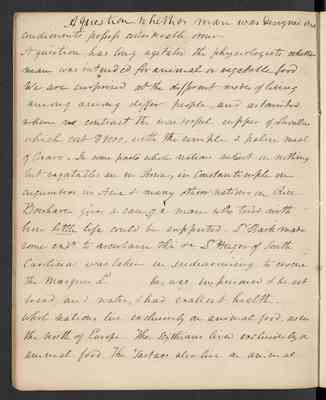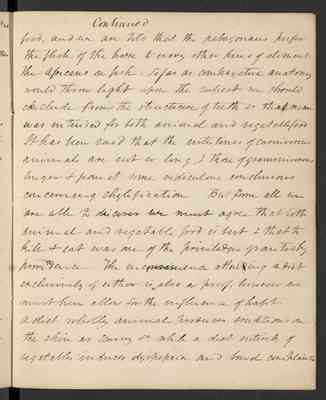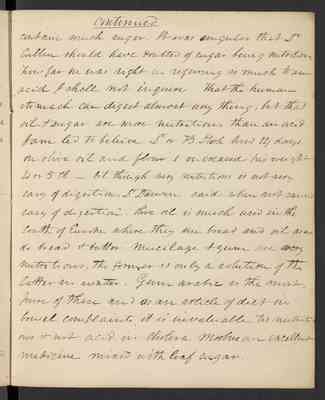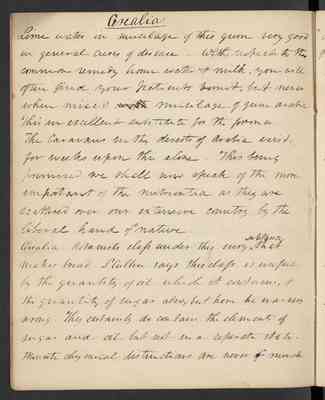Pages
16
A question whether man was designed et cet.
condiments possess considerable odour. A question has long agitated the physiologists whether man was intended for animal or vegatable food. We are surprised at the different modes of living among among differ people, and astonished when we contrast the wonderful supper of Lucallus which cost $9000, with the simple & palin meal of Coraro. In some parts whole nations subsist on nothing but vegatables as in Persia, in Constantinople on cucumbers, in Asia & many other nations on rice. Boeshave gives us a case of a man who tried with how little life could be supported. Dr. Stark made some expts to ascertain this &c. Dr. Hager of South Carolina was taken in endeavouring to rescue the Marquis L[ucullus] he was imprisoned and he eat bread and water, & had excellent health. Whole nations live exclusively on animal food, as in the north of Europe. The Scythians lived exclusively on animal food. The Tartans also live an animal
17
Continued
food, and we are told that the patagonians prefer the flesh of the horse to every other kind of aliment. The Africans on fish. So far as comparative anatomy would throw light upon the subject we should conclude from the structure of teeth &c that man was intended for both animal and vegatable food. It has been said that the intestines of carnivorous animals are not so long, & those of graniviorous longer & from it some ridiculous conclusions concerning chylification. But from all we are able to discover we must agree that both animal and vegatable food is best & that to kill & eat was one of the privileges granted by providence. The inconvenience attending a diet exclusively of either is also a proof, however we must here allow for the influence of habit. A diet wholly animal produces eruptions on the skin as scurvy c which a diet entirely of vegatables induces dyspepsia and bowel complaints.
18
Of Vegetable Food
But we are struck with admiration at the manner in which nature adapts food to climates & we may say with confidence that of the two vegatable diet in much the best. Sir George Stanton says that in China the inhabitants have none of these violent diseases which are found in European countries where so much flesh is used & that they never suffer from inflammation after surgical operation c. The same observation is applicable to Calcutta. We cannot say that this is entirely the result of vegatable food, but that it is in a great degree to be attributed to it. Of vegatable food. The parts of vegatables used as aliments are the seeds, roots c. As a general rule we may ascertain the quantity of vegatable nutriment in any article by the quantity of starch sugar soil which it contains, but there are some exceptions as the mushroom, onion c. The chyle after it is elaborated
19
continued
contains much sugar. It was singular that Dr Cullen should have doubted of sugar being nutritious, how far he was right in referring so much to an acid I shall not inquire. That the human stomach can digest almost any thing, but that oil & sugar are more nutritious than an acid I am led to believe. Dr B Stark lived 14 days on olive oil and flour & increased his weight 4 or 5 lb—oil though very nutritious is not very easy of digestion. Dr Darwin said when not rancid easy of digestion. Olive oil is much used in the south of Europe where they use bread and oil as we do bread & butter. Mucilage & gum are very nutritious, the former is only a solution of the latter in water. Gum arabic is the most pure of these and as an article of diet in bowel complaints it is invaluable, tis nutritous & not acid, in cholera morbus an excellent medicine mixed with loaf sugar.
20
Arealia
Lime water in mucilage of this gum very good in general cures of disease—With respect to the common remedy home water & milk, you will often find your patients vomit, but never when mixed with mucilage of gum arabic. This is excellent substitute for the former. The caravans in the deserts of Arabia exist for weeks upon this alone. This being premised we shall now speak of the more important of the nutrientia as they are scattered over our extensive country by the liberal hand of nature
Cerealia Botanists class under this every substance that makes bread. S Cullen says this class is useful by the quanitity of oil which it contains & the quantity of sugar also, but here he was very wrong. They certainly do contain the elements of sugar and oil but not in a seperate state. Minute chymical distincitons are never of much







